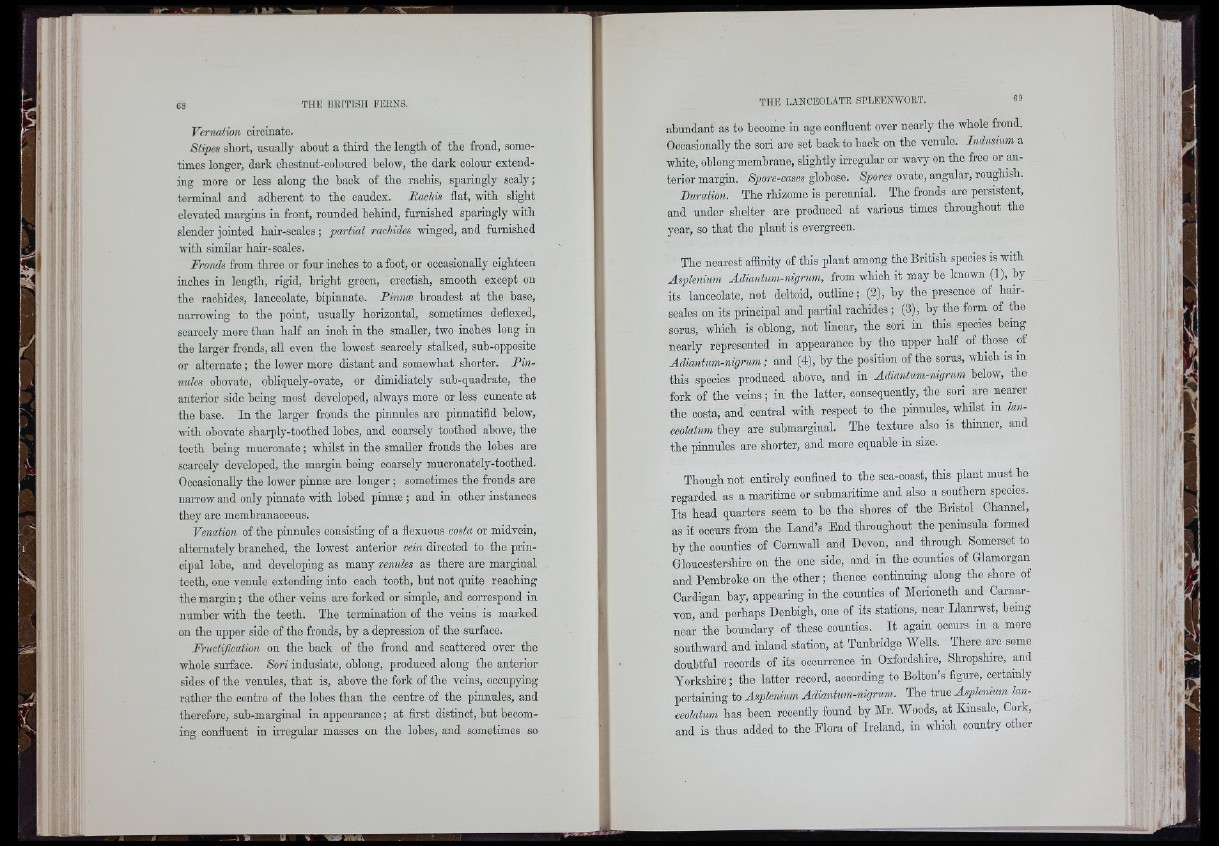
r
iv i
li
! ;; n; i ȓ
f :
Í:ü:
f.. . î i,
i)■.i
Vernation oii’cmate.
Stipes short, usually about a thii-d the length of the frond, sometimes
longer, dark chestnut-coloured below, the dark colour extending
more or less along tbe back of tbo racbis, sparingly scaly;
terminal and adherent to tbe caudex. Rachis flat, witb slight
elevated margins in front, rounded behind, furnished sparingly with
slender jointed bab’-scales ; partial rachides winged, and furnished
with similar bair-scales.
Fronds from three or four inches to a foot, or occasionally eighteen
inches in length, rigid, bright green, ereotisb, smooth except on
tbe rachides, lanceolate, bipinnate. Rinnm broadest at tbe base,
narrowing to tbe point, usually horizontal, sometimes deflexed,
scarcely more than half an inch in tbe smaller, two inches long in
the larger fronds, all even tbe lowest scarcely stalked, sub-opposite
or alternate ; tbe lower more distant and somewhat shorter. Rin-
nules obovate, obliquely-ovate, or dimidiatoly sub-quadrate, tbo
anterior side being most developed, always more or less cuneate at
tbe base. In tbe larger fronds tbe pinnules are pinnatifid below,
witb obovate sbarply-tootbed lobes, and coarsely tootbod above, tbe
teeth being mucronate ; whilst in tbe smaller fronds tbe lobes are
scarcely developed, the margin being coarsely mucronately-tootbed.
Occasionally tbe lower pinnæ are longer ; sometimes the fronds are
narrow and only pinnate witb lobed pinnæ ; and m other instances
they are membranaceous.
Venation of tbe pinnules consisting of a flexuous costa or midvoin,
alternately branched, tbe lowest anterior vein directed to tbe principal
lobe, and developing as many venules as there are marginal
teetb, one venule extending into each tooth, but not quite reaching
tbe margin ; tbe other veins are forked or simple, and correspond in
number witb the teeth. Tbe termination of tbe veins is marked
on the upper side of tbe fronds, by a depression of tbe surface.
Friietificatmi on tbe back of tbe frond and scattered over the
whole surface. Sox'i indusiate, oblong, produced along tbe anterior
sides of tbe venules, that is, above tbe fork of tbe veins, occupying
rather tbe centre of tbe lobes than tbe centre of tbe pinnules, and
therefore, sub-marginal in appearance ; at first distinct, but becoming
confluent in nregular masses on tbe lobes, and sometimes so
abundant as to become in age confluent over nearly tbe whole frond.
Occasionally tbe sori are set back to back on the venule. Indusium a
white, oblong membrane, slightly irregular or wavy on tbe free or anterior
margin. Spore-cases globoso. Spores ovate, angular, rougbisb.
Duration. Tbe rhizome is perennial. Tbe fronds are persistent,
and under shelter are produced at various times throughout tbe
year, so that tbe plant is evergreen.
The nearest affinity of tbis plant among tbe British species is with
Asplenium Adiantum-nigrum, from which it may be known (1), by
its lanceolate, not deltoid, outUne; (2), by tbo presence of bair-
soales on its principal and partial racbides ; (3), by tbe form of &0
sorus, which is oblong, not linear, tbe sori in tbis species being
nearly represented in appearance by tbe upper half of those of
Adiantum-nigrum; and (4), by tbe position of tbe sorus, wbiob is in
tbis species produced above, and in Adiantum-nigrum below, the
fork of tbe veins ; in tbe latter, consequently, tbe sori are nearer
tbe costa, and central witb respect to tbe pinnules, whilst in lanceolatum
they are submarginal. Tbe texture also is thinner, and
tbe pinnules are shorter, and more equable in size.
Though not entirely confined to tbe sea-ooast, this plant must bo
regarded as a maritime or submaritime and also a southern species.
Its bead quarters seem to be the shores of tbe Bristol Cbannol,
as it occurs from tbe Laud’s End throughout the peninsula formed
by tbe counties of Cornwall and Devon, and through Somerset to
Gloucestershire on tbe one side, and in tbe counties of Glamorgan
and Pembroke on tbe other ; thence continuing along tbe shore of
Cardigan bay, appearing in tbe counties of Merioneth and Carnarvon,
and perhaps Denbigh, one of its stations, near Llanrwst, being
near tbe boundary of tbese counties. It again occurs in a moro
southward and inland station, at Tunbridge Wells. There are some
doubtful records of its occurrence in Oxfordshire, Shropshire, and
Yorkshire; the latter record, according to Bolton’s figure, certainly
pertaining to Asplenium Adiantum-nigrum. Tbe true Asplenium lanceolatum
has been recently fonnd by Mr. Woods, at Kinsale, Cork,
and is tbns added to tbe Flora of Ireland, in which country other
nr i I
I
HI I
¡r-i
•f !
r
, . i | ‘l